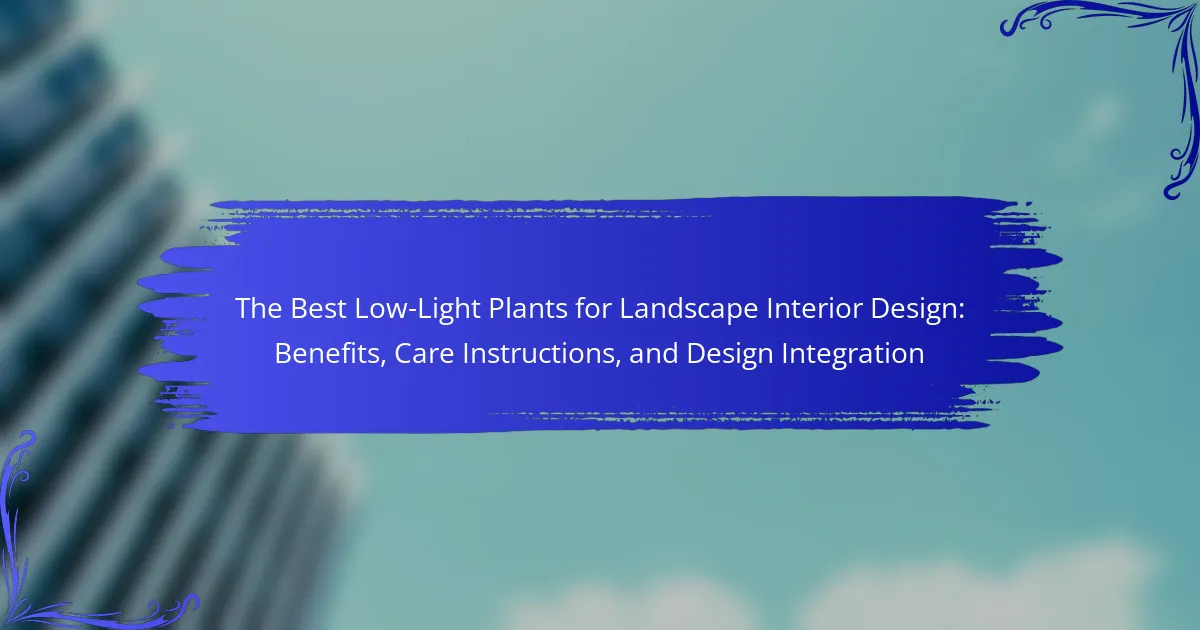Low-light plants, such as Snake Plant, ZZ Plant, Pothos, and Peace Lily, are ideal for enhancing landscape interior design due to their aesthetic appeal and air quality improvement capabilities. These plants thrive in minimal light conditions, require low maintenance, and contribute to a healthier indoor environment by filtering air pollutants and increasing oxygen levels. The article outlines specific care instructions for these plants, emphasizing the importance of indirect sunlight, sparing watering, and humidity monitoring. Additionally, it discusses how to integrate low-light plants into various design styles, enhancing ambiance while promoting relaxation and well-being.
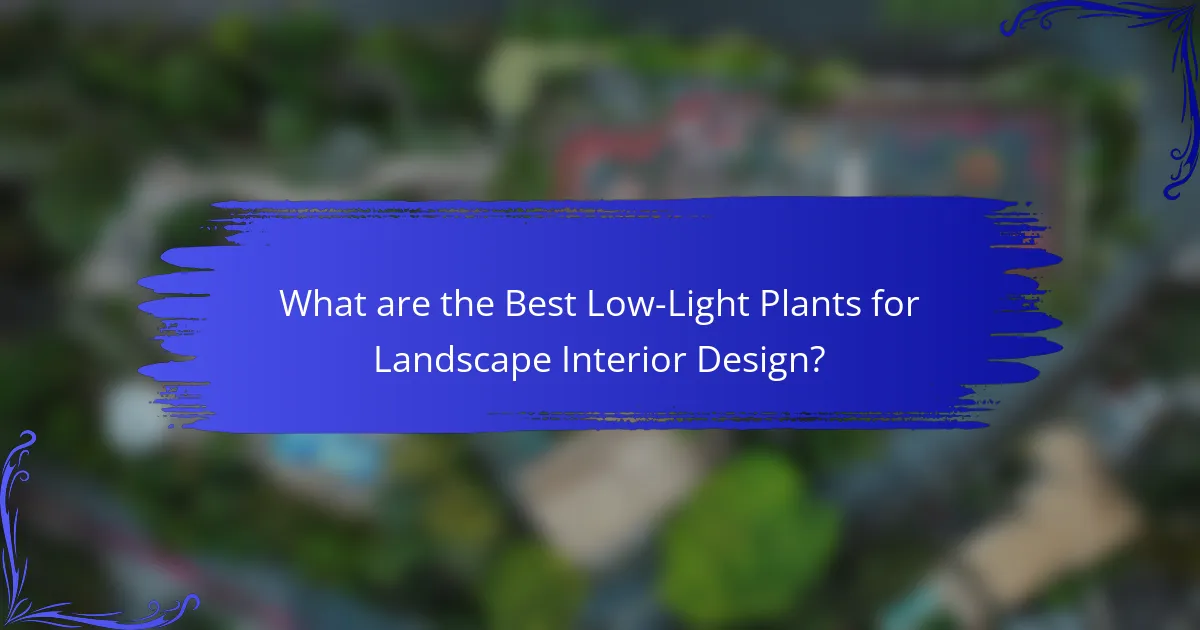
What are the Best Low-Light Plants for Landscape Interior Design?
The best low-light plants for landscape interior design include Snake Plant, ZZ Plant, Pothos, and Peace Lily. Snake Plant thrives in low light and requires minimal water. It can grow up to 4 feet tall. ZZ Plant is known for its glossy leaves and can survive in very low light. Pothos is versatile and can be trained to grow in various directions. Peace Lily produces beautiful white flowers even in low light conditions. These plants are not only aesthetically pleasing but also improve indoor air quality. Studies show that indoor plants can reduce stress and enhance mood.
Why are low-light plants important for interior landscapes?
Low-light plants are important for interior landscapes because they thrive in environments with limited natural light. These plants enhance indoor aesthetics by adding greenery and visual interest. They help improve indoor air quality by filtering toxins and releasing oxygen. Studies show that indoor plants can reduce stress and increase productivity. Low-light plants are also low-maintenance, making them ideal for busy individuals. They adapt well to various interior settings, from homes to offices. Their resilience allows them to flourish in diverse conditions, contributing to sustainable design. Overall, low-light plants are essential for creating healthy and visually appealing indoor spaces.
What are the characteristics of low-light plants?
Low-light plants typically thrive in environments with minimal natural light. They possess large, broad leaves to maximize light absorption. These plants often exhibit slower growth rates compared to those requiring more light. Low-light plants usually have a high tolerance for shade. They are often native to understory environments in forests. Many low-light plants can survive with indirect sunlight or artificial light. Some examples include snake plants and pothos. These characteristics enable them to adapt to indoor spaces with limited lighting conditions.
How do low-light plants contribute to indoor air quality?
Low-light plants improve indoor air quality by absorbing carbon dioxide and releasing oxygen. They also filter harmful pollutants from the air. Common low-light plants, such as snake plants and peace lilies, can remove toxins like formaldehyde and benzene. Studies show that indoor plants can reduce airborne volatile organic compounds (VOCs). NASA’s Clean Air Study highlighted the air-purifying abilities of various houseplants. The presence of these plants can lead to a healthier indoor environment. Enhanced air quality can improve overall well-being and productivity.
What are the top low-light plants recommended for interior design?
The top low-light plants recommended for interior design include the Snake Plant, Pothos, ZZ Plant, and Peace Lily. Snake Plants are known for their air-purifying qualities and can survive in low light. Pothos is a versatile plant that thrives in various lighting conditions and is easy to care for. The ZZ Plant is drought-tolerant and can grow in low-light areas, making it ideal for darker spaces. Peace Lilies not only add beauty with their white blooms but also improve indoor air quality. These plants are frequently suggested by interior designers for their aesthetic appeal and resilience in low-light environments.
Which low-light plants are best for beginners?
The best low-light plants for beginners include the Snake Plant, Pothos, and ZZ Plant. Snake Plants are resilient and can survive in low light. They require minimal watering and thrive on neglect. Pothos is known for its trailing vines and adaptability. It grows well in various lighting conditions and is easy to propagate. ZZ Plants are exceptionally low-maintenance and can tolerate low light. They have a unique glossy appearance and require infrequent watering. These plants are ideal for novice gardeners due to their forgiving nature and ease of care.
What unique attributes do specific low-light plants offer?
Specific low-light plants offer unique attributes such as adaptability to low light conditions and air-purifying capabilities. For example, the Snake Plant thrives in minimal light while filtering toxins like formaldehyde from the air. The Pothos is another low-light plant that can grow in various environments and is known for its ability to remove indoor pollutants. The ZZ Plant is notable for its drought resistance and glossy leaves, making it visually appealing in dim spaces. These attributes make low-light plants ideal for enhancing indoor environments where natural light is limited.
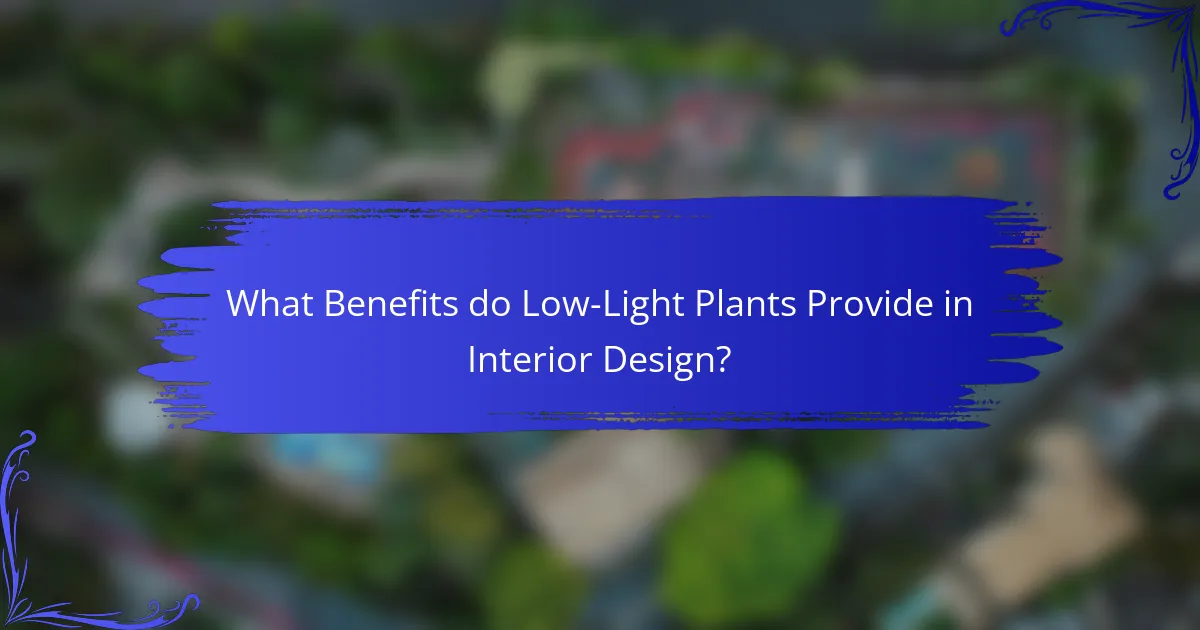
What Benefits do Low-Light Plants Provide in Interior Design?
Low-light plants enhance interior design by improving air quality and adding aesthetic appeal. They filter indoor air pollutants, contributing to a healthier living environment. Studies show that plants can reduce levels of carbon dioxide and increase oxygen levels. Additionally, low-light plants require minimal maintenance, making them ideal for busy lifestyles. Their diverse shapes and colors can complement various design styles. They also create a calming atmosphere, promoting relaxation and well-being. Incorporating low-light plants can increase property value by enhancing the overall ambiance.
How do low-light plants enhance aesthetics in interior spaces?
Low-light plants enhance aesthetics in interior spaces by adding greenery and texture. They create a calming environment and improve visual interest. These plants can fit into various design styles, from modern to rustic. Low-light plants also contribute to color variation, introducing shades of green and other colors. Their presence can soften hard edges in a room, making spaces feel more inviting. Studies show that indoor plants can increase feelings of well-being and reduce stress. Additionally, they can improve air quality, which complements their aesthetic benefits. Overall, low-light plants serve both functional and decorative purposes in interior design.
What are the psychological benefits of incorporating plants indoors?
Incorporating plants indoors offers significant psychological benefits. These benefits include reduced stress and anxiety levels. Studies show that interacting with indoor plants can lower cortisol levels, a stress hormone. Additionally, plants enhance mood and promote feelings of well-being. Research indicates that being around greenery can lead to increased happiness and satisfaction. Improved concentration and productivity are also noted benefits. A study published in the Journal of Environmental Psychology found that plants in workspaces boost focus and cognitive function. Furthermore, indoor plants can foster a sense of connection to nature. This connection can enhance overall mental health and emotional resilience.
How does greenery affect productivity and well-being?
Greenery positively affects productivity and well-being by enhancing mood and reducing stress. Studies show that plants in workspaces can increase productivity by up to 15%. Exposure to greenery improves air quality, which contributes to better cognitive function. A study published in the Journal of Environmental Psychology found that natural elements in a workspace boost creativity. Furthermore, greenery promotes a sense of calm and satisfaction, leading to improved mental health. Research indicates that people working in green environments report higher levels of happiness. Incorporating plants into interior design not only beautifies spaces but also fosters a healthier work atmosphere.
What practical advantages do low-light plants offer?
Low-light plants provide several practical advantages in interior design. They thrive in environments with limited natural light. This adaptability makes them ideal for spaces like offices and homes with few windows. Low-light plants also require less frequent watering compared to other plants. This characteristic makes them low-maintenance options for busy individuals. Additionally, they can improve indoor air quality by filtering toxins. Studies show that plants like snake plants and pothos can remove harmful substances from the air. Their aesthetic appeal adds greenery and life to any space. Overall, low-light plants enhance both the functionality and beauty of interior environments.
How do low-light plants require less maintenance?
Low-light plants require less maintenance due to their adaptability to low light conditions. These plants have evolved to thrive in environments with minimal sunlight. As a result, they require less frequent watering compared to high-light plants. Low-light plants also tend to have slower growth rates. This slower growth means they need less pruning and repotting. Additionally, many low-light plants are more resilient to pests and diseases. This resilience further reduces the need for constant monitoring and intervention. Overall, their natural adaptations contribute to lower care requirements.
In what ways can low-light plants save energy costs?
Low-light plants can save energy costs by reducing the need for artificial lighting. They thrive in low-light environments, allowing for less reliance on electric lights during the day. This can lead to significant savings on electricity bills. Additionally, low-light plants can improve indoor air quality. Improved air quality can enhance overall well-being and potentially reduce health-related costs. Studies show that plants can increase humidity and reduce airborne pollutants. This reduces the need for energy-intensive air purification systems. Overall, incorporating low-light plants into interior spaces can lead to both direct and indirect energy savings.
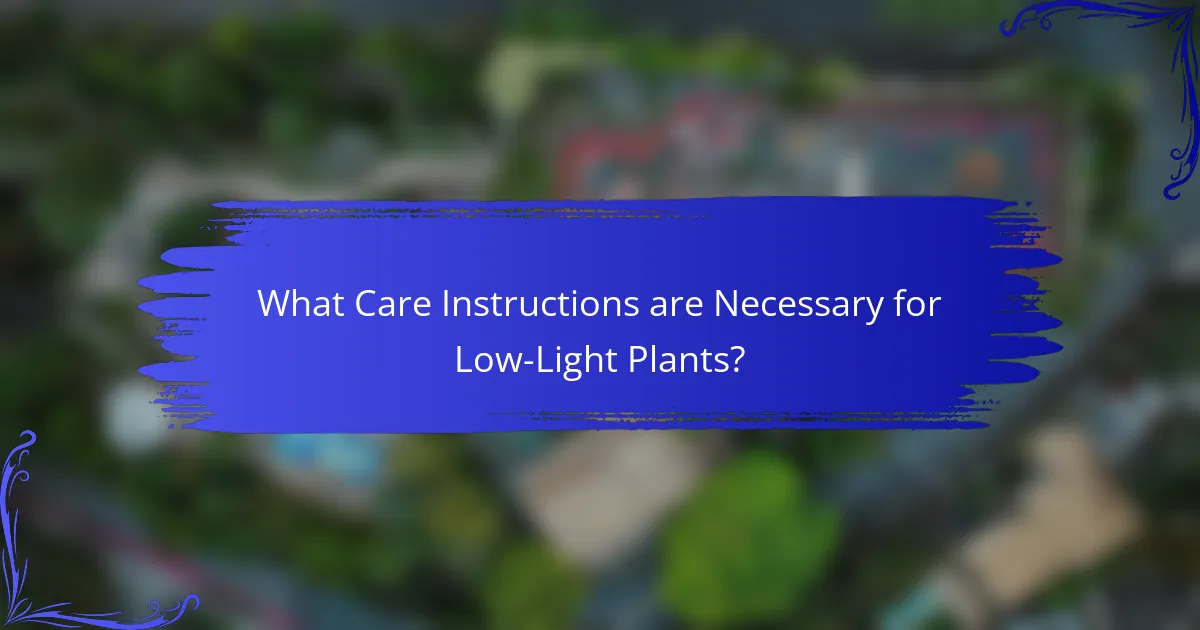
What Care Instructions are Necessary for Low-Light Plants?
Low-light plants require specific care instructions to thrive. First, they should be placed in areas with indirect sunlight. This mimics their natural habitat, where they often grow under larger plants. Watering should be done sparingly, allowing the soil to dry out between waterings. Overwatering can lead to root rot, a common issue for these plants. Fertilizing should occur less frequently, typically every 6-8 weeks during the growing season. Using a balanced, diluted fertilizer is recommended. Humidity levels should be monitored, as many low-light plants prefer higher humidity. Regular dusting of leaves helps them absorb light more effectively. Finally, periodic rotation of the plants can ensure even growth on all sides.
How can you ensure proper watering for low-light plants?
To ensure proper watering for low-light plants, monitor the soil moisture levels regularly. Low-light plants typically require less water than those in bright light. Use your finger to check the top inch of soil. If it feels dry, it is time to water. Water thoroughly until it drains from the bottom of the pot. This ensures the roots receive adequate moisture. Avoid letting the plant sit in standing water, which can lead to root rot. Adjust your watering frequency based on the season and humidity levels. During winter, many low-light plants require even less water.
What signs indicate overwatering or underwatering in low-light plants?
Signs of overwatering in low-light plants include yellowing leaves and root rot. The leaves may also become soft and mushy. Additionally, wilting can occur despite wet soil. In contrast, underwatering signs include browning leaf tips and dry, crispy leaves. The plant may also show drooping and stunted growth. Monitoring soil moisture is crucial for identifying these conditions. Overwatering typically leads to a lack of oxygen in the roots, while underwatering causes dehydration. Understanding these signs helps maintain plant health effectively.
How does humidity affect the health of low-light plants?
Humidity significantly affects the health of low-light plants. Low humidity can lead to dry leaves and stunted growth. Plants may show signs of stress, such as browning leaf tips. Conversely, high humidity levels can promote healthy growth and vibrant foliage. Optimal humidity ranges from 40% to 60% for many low-light plants. Research indicates that humidity levels below 30% can cause issues like leaf drop. Maintaining proper humidity levels supports photosynthesis and nutrient uptake. This balance is crucial for overall plant vitality and resilience.
What are the best soil and potting practices for low-light plants?
The best soil and potting practices for low-light plants include using well-draining potting mix and selecting appropriate pot size. A potting mix designed for houseplants, containing peat moss, perlite, and vermiculite, provides adequate drainage and aeration. Low-light plants generally prefer slightly acidic to neutral pH levels, around 6.0 to 7.0. When potting, ensure the container has drainage holes to prevent waterlogging. Repotting every couple of years helps refresh nutrients and promotes healthy growth. Additionally, avoid overwatering, as low-light plants typically require less moisture. Following these practices supports the health and longevity of low-light plants.
Which types of soil are ideal for low-light plants?
Well-draining soil types are ideal for low-light plants. These soils often include potting mix, loamy soil, and peat-based soil. Well-draining soil prevents waterlogging, which can harm low-light plants. Potting mix typically contains organic materials that retain moisture while allowing excess water to drain. Loamy soil combines sand, silt, and clay, providing a balanced structure for root growth. Peat-based soil offers excellent moisture retention and aeration. These soil types support the growth of low-light plants by ensuring proper drainage and nutrient availability.
How important are drainage and pot selection for low-light plants?
Drainage and pot selection are crucial for low-light plants. Proper drainage prevents waterlogging, which can lead to root rot. Low-light plants often require less water, making drainage even more significant. Selecting the right pot ensures adequate airflow and moisture retention. Pots with drainage holes facilitate excess water escape. Additionally, the material of the pot can impact soil moisture levels. Terracotta pots, for instance, absorb moisture, while plastic retains it. Research indicates that well-drained soil significantly improves plant health and growth. Therefore, attention to drainage and pot selection is essential for the success of low-light plants.
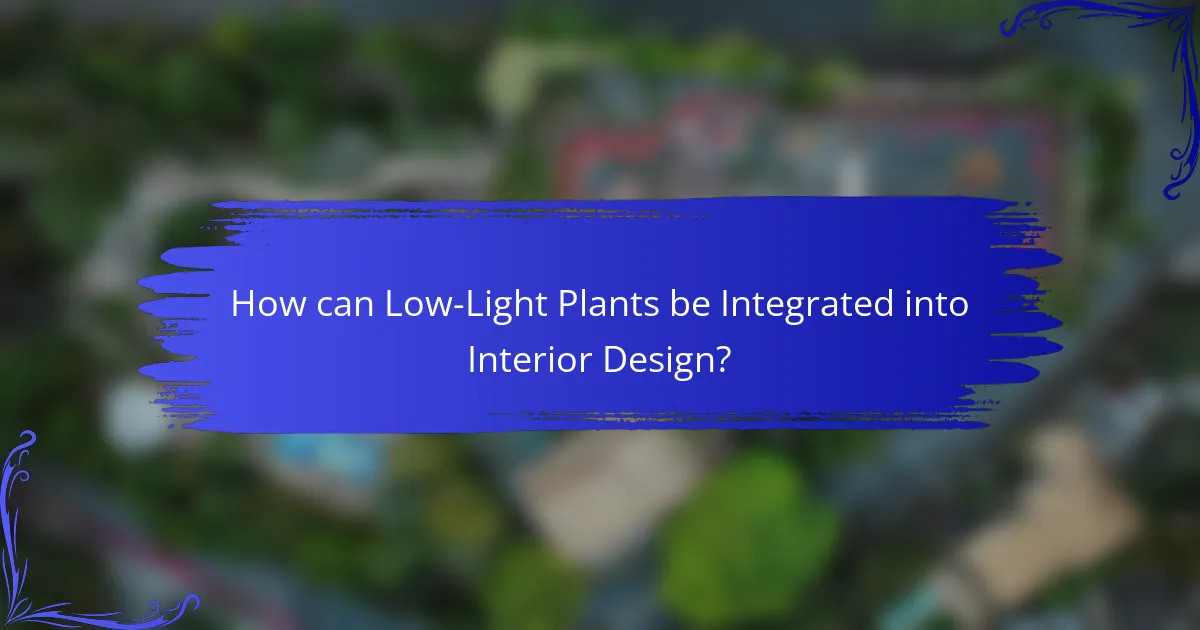
How can Low-Light Plants be Integrated into Interior Design?
Low-light plants can be integrated into interior design by strategically placing them in areas with minimal natural light. These plants thrive in low-light conditions, making them ideal for spaces like offices or shaded rooms. Incorporating them into design enhances aesthetics and promotes well-being. Popular choices include snake plants and pothos, which require little maintenance. Designers often use these plants to add color and texture to various settings. Additionally, using decorative pots can complement the overall decor. Studies show that indoor plants improve air quality, further benefiting occupants.
What design principles should be considered when using low-light plants?
When using low-light plants, consider placement, scale, and texture. Proper placement ensures plants receive adequate indirect light. Scale relates to the size of the plants in relation to the space. Using varying heights creates visual interest and depth. Texture adds dimension and can enhance the overall aesthetic. Grouping plants can create a cohesive look and improve the design. Additionally, ensure that the color palette of the plants complements the interior design. These principles help in creating a balanced and inviting environment with low-light plants.
How can low-light plants be used to create focal points in a room?
Low-light plants can be used to create focal points in a room by strategically placing them in key areas. Positioning taller plants in corners draws the eye upward. Grouping smaller plants on shelves or tables adds visual interest. Using unique planters enhances the overall aesthetic. Plants like snake plants or pothos thrive in low light and provide a lush appearance. These plants can also improve air quality, adding an extra benefit. Their varied textures and colors contribute to a dynamic space. Incorporating lighting to highlight these plants can further enhance their impact.
What styles of interior design benefit most from low-light plants?
Biophilic design, minimalist design, and contemporary design benefit most from low-light plants. Biophilic design emphasizes the connection between nature and interior spaces. Low-light plants enhance this connection by bringing greenery indoors. Minimalist design focuses on simplicity and functionality. Low-light plants add visual interest without overwhelming the space. Contemporary design often features open layouts and natural materials. Low-light plants complement these elements, providing a fresh aesthetic. Studies indicate that incorporating plants can improve mood and productivity, making them valuable in these design styles.
What are some creative ways to display low-light plants?
Creative ways to display low-light plants include using wall-mounted planters. These planters save floor space and add vertical interest. Hanging planters also work well. They draw the eye upward and create a layered look. Terrariums provide a unique display option. They allow for a mini ecosystem that can thrive in low light. Use shelves to create a plant wall. This method showcases multiple plants at different heights. Grouping plants together in clusters enhances visual appeal. Using decorative pots can complement home decor. Finally, corner stands utilize often-overlooked spaces effectively.
How can vertical gardens enhance the use of low-light plants?
Vertical gardens can significantly enhance the use of low-light plants by optimizing space and light exposure. These gardens create a vertical growing environment that maximizes available light, even in shaded areas. Low-light plants can thrive in this setup as they are often adapted to grow in indirect light. The vertical structure allows for better air circulation, reducing humidity levels that can lead to mold growth. Additionally, vertical gardens can utilize reflective materials to increase light [censured]. This arrangement also facilitates easier maintenance and watering, promoting healthier plant growth. Studies show that vertical gardens can improve indoor air quality, benefiting low-light plants and their surroundings.
What are the benefits of using planters and terrariums for low-light plants?
Using planters and terrariums for low-light plants enhances their growth and aesthetic appeal. Planters provide a controlled environment that retains moisture. This is beneficial for low-light plants, which often require consistent humidity. Terrariums create a mini-ecosystem that recycles moisture. This reduces the need for frequent watering. The glass structure of terrariums allows for light diffusion. This is ideal for plants that thrive in indirect light. Additionally, planters and terrariums can be designed to fit various interior styles. This makes them versatile decorative elements in landscape interior design.
What are the best practices for maintaining low-light plants in interior design?
The best practices for maintaining low-light plants in interior design include selecting suitable plant species, providing adequate water, and ensuring proper humidity levels. Choose plants like snake plants and pothos, which thrive in low light. Water these plants only when the top inch of soil is dry to prevent overwatering. Maintain humidity levels between 40% to 60% for optimal growth. Rotate plants occasionally to ensure even light exposure. Clean leaves regularly to remove dust and enhance photosynthesis. Fertilize sparingly, using a balanced fertilizer during the growing season. These practices ensure healthy growth and longevity of low-light plants in interior spaces.
The main entity of this article is low-light plants, specifically focusing on their benefits, care instructions, and integration into landscape interior design. Key low-light plants discussed include Snake Plant, ZZ Plant, Pothos, and Peace Lily, highlighting their aesthetic appeal, air-purifying qualities, and low maintenance requirements. The article outlines the significance of low-light plants in enhancing indoor environments, improving air quality, and contributing to overall well-being. Additionally, it provides practical care tips, optimal soil and potting practices, and creative display ideas to effectively incorporate these plants into various interior design styles.
